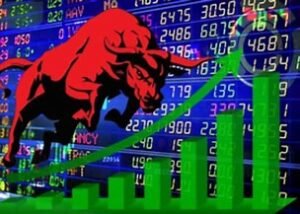On June 10, 2024, the Indian stock market experienced a historic surge, with the BSE Sensex breaching the 77,000-mark for the first time and the NSE Nifty hitting an all-time high. This remarkable rally occurred a day after Narendra Modi was sworn in for his third consecutive term as Prime Minister. The Sensex jumped 385.68 points to reach a record high of 77,079.04, while the Nifty climbed 121.75 points to a lifetime peak of 23,411.90.
Modi’s Historic Third Term
Narendra Modi’s third consecutive term as Prime Minister marks a significant political achievement, making him only the second leader after Jawaharlal Nehru to achieve this feat. The swearing-in ceremony at Rashtrapati Bhavan in Delhi saw key BJP leaders, including Rajnath Singh, Amit Shah, Nitin Gadkari, Nirmala Sitharaman, and S Jaishankar, retaining their senior cabinet positions. This continuity in leadership is perceived positively by the market, signaling stability and experience in governance.
Market Reaction to Election Results
The stock market’s response to the political landscape has been volatile since the exit poll predictions on June 1, 2024. The market initially surged on June 3, anticipating a sweeping victory for Modi’s NDA government. However, on June 4, the actual results day, the market crashed as the counting trends deviated from the exit polls, leading to uncertainty.
Despite this, the BJP secured 240 seats, a decrease from its 2019 tally, but still managed to achieve a comfortable majority with its NDA allies, including JD(U) and TDP, bringing the total to 293 seats. The opposition INDIA bloc defied expectations by winning 234 seats, contributing to the initial market uncertainty.
Record Highs Post-Oath Ceremony

The market rebounded swiftly after the initial crash, reaching new heights post-oath ceremony. Analysts attribute this recovery to the smooth transition in government formation and the reassurance of political stability. The Sensex and Nifty opened at record highs on June 10, with Sensex at 76,890.34 points, up by 0.3%, and Nifty at 23,372 points, up by 0.4%.
Factors Influencing the Market
Several factors contributed to the market’s uptrend. Key among them was the anticipation of the upcoming US Federal Reserve interest rate decision and India’s inflation data, both retail and wholesale. India’s retail inflation eased slightly to 4.83% in April, down from 4.85% in March, though consumer food price inflation surged to 8.70% from 8.52%. Despite this, the inflation remains within the RBI’s comfort range of 2-6%, albeit above the ideal 4% scenario.
Expert Insights
Ajit Mishra, SVP, Research at Religare Broking Ltd, emphasized the resilience among market participants despite the initial post-election decline. He noted the renewed participation of sectors like IT and FMCG, previously on the sidelines, bolstering confidence. Mishra advised traders to remain cautious and focus on stocks aligned with benchmark movements.
Siddhartha Khemka, Head of Retail Research at Motilal Oswal Financial Services Ltd, highlighted the importance of upcoming cabinet portfolio allocations in influencing market sentiment. He anticipated continued market volatility with an upward bias.
V K Vijayakumar, Chief Investment Strategist at Geojit Financial Services, pointed out the robust buying power and optimism of retail investors. He noted that on June 4, when Nifty fell by 5.9%, retail investors bought equity worth Rs 21,179 crores, showcasing their confidence. Vijayakumar advised caution against chasing highly valued mid and small-cap stocks, suggesting safety in large-cap investments.
The Indian stock market’s journey from the initial crash post-election results to reaching record highs underscores the complex interplay of political stability, investor sentiment, and economic indicators. Narendra Modi’s third term as Prime Minister has instilled confidence in the market, evidenced by the swift recovery and new peaks in Sensex and Nifty. As the new government settles and key economic decisions unfold, the market is expected to remain dynamic, with a focus on upcoming inflation data, US Fed decisions, and cabinet portfolio allocations.











